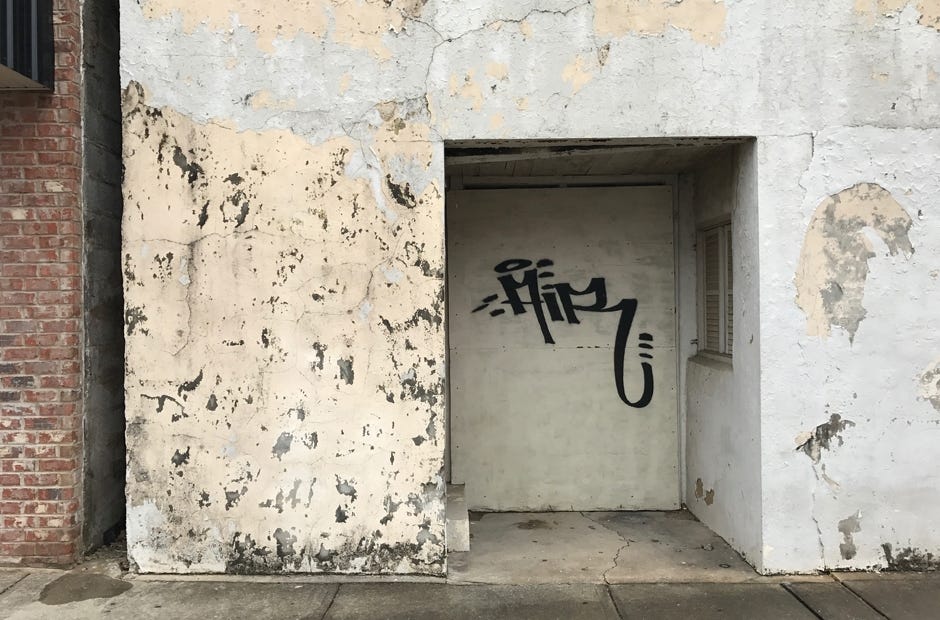![A vacant building on downtown's Main Street is tagged with spray paint. [MARK JUDSON/NEWS BULLETIN]](http://127.0.0.1/wordpress/wp-content/uploads/2022/01/ghows-DA-49877b25-2d08-75ed-e053-0100007f30e0-0ae0e477.jpeg)
CRESTVIEW—Motorists driving over the hill on South Ferdon Boulevard get a glimpse of downtown, passing trains and, recently, graffiti.
Vacant structures in Crestview have become spray paint victims over the past several months. The downtown area hasn’t been the only affected area; tagging has been seen in residential areas and on property in Laurel Hill. The occurrences have grabbed the attention of Councilman Shannon Hayes, who commented on the graffiti at a recent City Council meeting, and Crestview Police Chief Tony Taylor.
“We’re on it,” Taylor said. “We’ve been investigating it but unfortunately these are individuals likely working at night, see a police car and are gone.”
The department began noticing the influx of spray paint incidents in recent months. The tags have been seen in all areas of the city and aren’t concentrated in certain neighborhoods or sections of town. This and the content of the vandalism lead CPD to believe the graffiti isn’t gang-related.
“What we’ve seen isn’t necessarily gang tags; at least not that I’ve interpreted,” Taylor said. “The fact that they are scattered backs that up as well. In gang situations, you see more concentrated work because they are marking territory — we’re not seeing that here.”
While the tagging might not be gang-related, it still has some residents concerned.
“Crestview is just starting to expand and pull itself together,” resident Georgiana Nance said. “Having spray paint all over the city buildings sends a message we should not send.”
“[Spray paint] on random buildings is not acceptable,” Aimee Gudinas, another Crestview resident, said. She offered an alternative solution to handling graffiti in town — providing a legal means for street art within city limits.
“I have noticed that the artwork on the brick buildings downtown really needs to be touched up,” Gudinas said. “That would be a good place to start. Hang some flyers on the buildings that are getting graffiti and ask for volunteers.”
Several other Florida cities have experimented with public venues for street artists to display work. Pensacola has Graffiti Bridge, which features an ever-changing display of spray paint projects and tagging. Downtown Tampa allows artists to use utility boxes at intersections as their canvas. Jacksonville has begun licensing walls of vacant buildings to painters and artists for creative displays. Palatka, known as the City of Murals, has a municipal council to regulate murals and street paintings in town.
“I think the graffiti is cool, to be honest,” resident Anna Rave said. “But it being on the side of buildings, or being done illegally, is wrong.”
Having a place where artists could legally attach their work would solve “a lot” of the graffiti problems, Rave added.
“Some of these people are talented, aspiring artists,” Taylor said. However, some of the work is far from skilled and, regardless of the artist’s ability, producing displays on vacant buildings is still illegal, he added.
A person caught spray painting a building could be charged with criminal mischief and fined at least the cost of repairs, possibly more, depending on the court system, according to Taylor. Investigators would also explore possible connections between a suspect and other pieces throughout town.
Certain stylistic similarities can be found to connect multiple acts of vandalism, Taylor said. Graffiti artists also sometimes sign work with their name, alias or initials—all of which can be used to link crimes.
Contact the Crestview Police Department, 682-3544, for any information regarding graffiti or vandalism in town.

This article originally appeared on Crestview News Bulletin: Graffiti vandals raise concern
